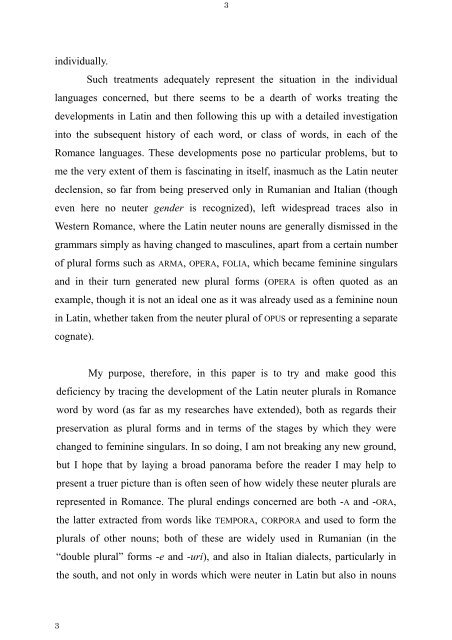The Latin Neuter Plurals in Romance - Page ON
The Latin Neuter Plurals in Romance - Page ON
The Latin Neuter Plurals in Romance - Page ON
You also want an ePaper? Increase the reach of your titles
YUMPU automatically turns print PDFs into web optimized ePapers that Google loves.
<strong>in</strong>dividually.<br />
3<br />
3<br />
Such treatments adequately represent the situation <strong>in</strong> the <strong>in</strong>dividual<br />
languages concerned, but there seems to be a dearth of works treat<strong>in</strong>g the<br />
developments <strong>in</strong> <strong>Lat<strong>in</strong></strong> and then follow<strong>in</strong>g this up with a detailed <strong>in</strong>vestigation<br />
<strong>in</strong>to the subsequent history of each word, or class of words, <strong>in</strong> each of the<br />
<strong>Romance</strong> languages. <strong>The</strong>se developments pose no particular problems, but to<br />
me the very extent of them is fasc<strong>in</strong>at<strong>in</strong>g <strong>in</strong> itself, <strong>in</strong>asmuch as the <strong>Lat<strong>in</strong></strong> neuter<br />
declension, so far from be<strong>in</strong>g preserved only <strong>in</strong> Rumanian and Italian (though<br />
even here no neuter gender is recognized), left widespread traces also <strong>in</strong><br />
Western <strong>Romance</strong>, where the <strong>Lat<strong>in</strong></strong> neuter nouns are generally dismissed <strong>in</strong> the<br />
grammars simply as hav<strong>in</strong>g changed to mascul<strong>in</strong>es, apart from a certa<strong>in</strong> number<br />
of plural forms such as ARMA, OPERA, FOLIA, which became fem<strong>in</strong><strong>in</strong>e s<strong>in</strong>gulars<br />
and <strong>in</strong> their turn generated new plural forms (OPERA is often quoted as an<br />
example, though it is not an ideal one as it was already used as a fem<strong>in</strong><strong>in</strong>e noun<br />
<strong>in</strong> <strong>Lat<strong>in</strong></strong>, whether taken from the neuter plural of OPUS or represent<strong>in</strong>g a separate<br />
cognate).<br />
My purpose, therefore, <strong>in</strong> this paper is to try and make good this<br />
deficiency by trac<strong>in</strong>g the development of the <strong>Lat<strong>in</strong></strong> neuter plurals <strong>in</strong> <strong>Romance</strong><br />
word by word (as far as my researches have extended), both as regards their<br />
preservation as plural forms and <strong>in</strong> terms of the stages by which they were<br />
changed to fem<strong>in</strong><strong>in</strong>e s<strong>in</strong>gulars. In so do<strong>in</strong>g, I am not break<strong>in</strong>g any new ground,<br />
but I hope that by lay<strong>in</strong>g a broad panorama before the reader I may help to<br />
present a truer picture than is often seen of how widely these neuter plurals are<br />
represented <strong>in</strong> <strong>Romance</strong>. <strong>The</strong> plural end<strong>in</strong>gs concerned are both -A and -ORA,<br />
the latter extracted from words like TEMPORA, CORPORA and used to form the<br />
plurals of other nouns; both of these are widely used <strong>in</strong> Rumanian (<strong>in</strong> the<br />
“double plural” forms -e and -uri), and also <strong>in</strong> Italian dialects, particularly <strong>in</strong><br />
the south, and not only <strong>in</strong> words which were neuter <strong>in</strong> <strong>Lat<strong>in</strong></strong> but also <strong>in</strong> nouns









